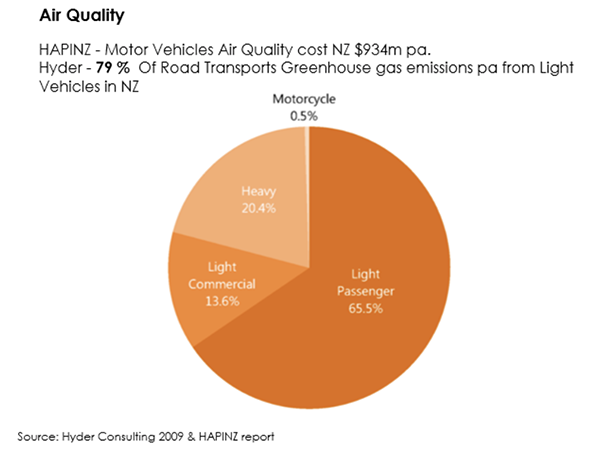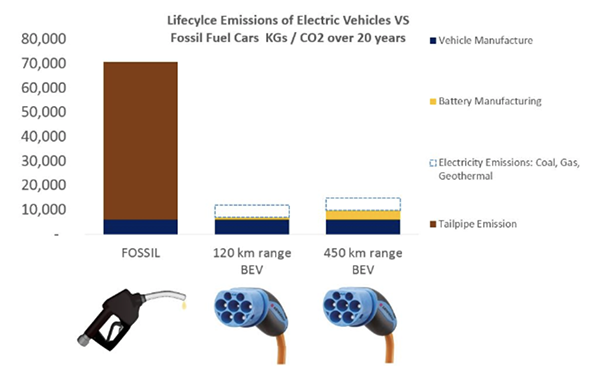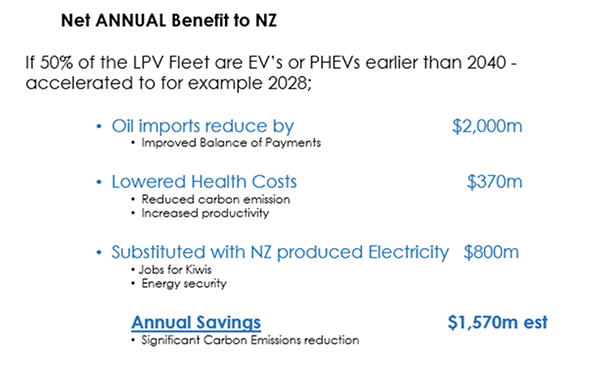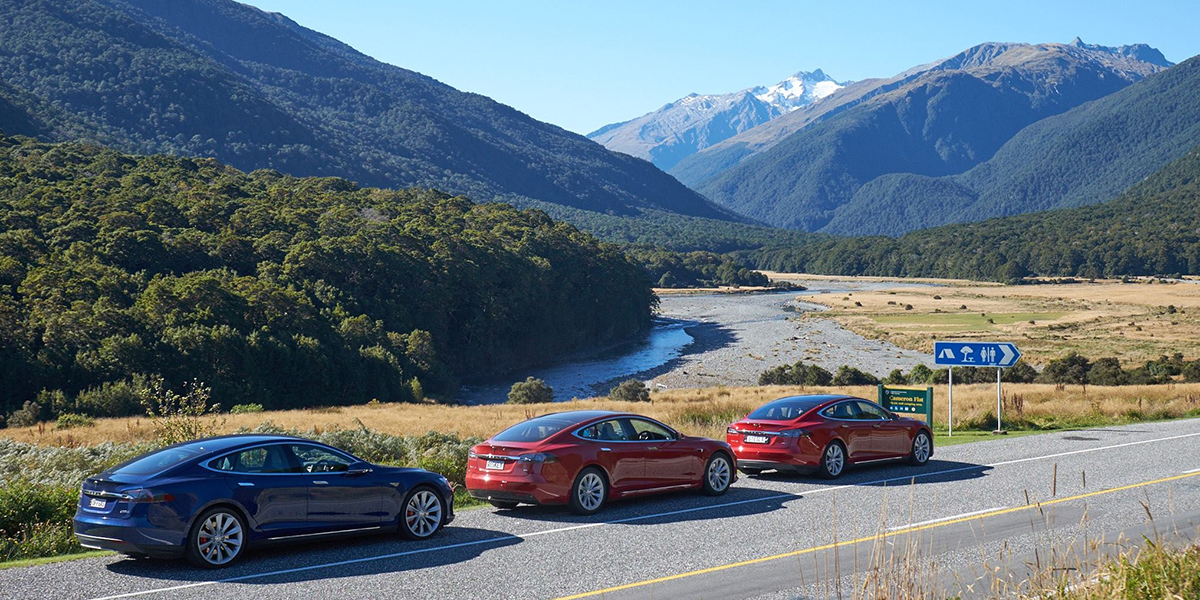As an advocate for keeping New Zealand clean and green, Ecotricity are a large part of jump starting the electric car movement within New Zealand. We started in 2014 by making sure our vehicle fleet was 100% plug-in electric and we haven’t looked back since. Not only does our fleet now reflect our philosophy, but it actively contributes towards positive climate change, benefits the health and wellbeing of kiwis and adds to our economy.
So, why electrify? The answers are simple. Air Quality, Climate Change and Lowering Transport Costs.
Air Quality
Let’s start with what separates Earth from the other eight planets in our solar system. Oxygen! It’s what makes life possible, however, it’s often taken for granted. Combustion engines are a major cause of greenhouse gas emissions.
Here are some interesting stats that speak for themselves;
- In New Zealand, air pollution from vehicles alone is estimated to result in 500 Premature Deaths and 712,000 restricted activity days each year
- In Europe, 75,000 deaths resulted from nitrogen dioxide, mainly from diesel vehicles
- In the US, the Massachusetts Institute of Technology (MIT) calculated 53,000 premature deaths result from vehicle pollutants each year
- In China, 920,000 deaths a year were attributed to outdoor pollution, such as the particulate matter spread by power plants and vehicle emissions

Cradle to Grave Greenhouse Gas Emissions of Vehicles
Emissions don’t only refer to fumes exuding from your tailpipe. There are emissions produced in the manufacture of vehicles as well. The manufacture of EV motors is much lighter than combustion motors, partly because EVs themselves are much lighter vehicles. The flip side is that EVs require batteries. A Tesla battery can weigh up to half a tonne and the bigger the battery, the higher the manufacturing emissions. Despite this, EVs don’t come close to matching combustion engine vehicles on the emissions scale.
The average Kiwi passenger vehicle with a combustion engine emits 3,240 kg / CO2 each year. Over a 20 year lifetime that equates to around 64,800 kg/CO2e. The average electricity related emissions from an EV are around 250 KG/CO2 per annum, or 5,000 kg/CO2e over 20 years. What’s even better is that if you’re recharging your EV using 100% carboNZero certified renewable electricity from Ecotricity, then your electricity emissions are ZERO kg/CO2e. This means that electric vehicles prove 7-10 times more CO2e efficient than standard combustion engine vehicles over their full lifetime using 100% carboNZero certified electricity.
There aren’t only the emissions to consider, the perks of an EV are performance based as well. Without an engine, EVs will last much longer and require much less maintenance than combustion vehicles. The Tesla Model S taxi for example, has driven 320 000 km in under 14 months. That is 20 times the average annual Kiwi distance and it still retained 94% of its battery capacity.
We’ve covered the manufacturing and lifespan of an EV, but what happens next?
When your EV has done 300,000+ km its lithium battery can still support stationary energy storage. It’s not uncommon for batteries to be re-used to capture energy in the home or generated from a private solar system. If repurposing is no longer an option, companies like Tesla are already recycling Lithium batteries and achieving up to a 60% recycle rate. The Nissan LEAF in its entirety is already 95% recyclable. Up to 20% of the materials used in manufacturing the LEAF are derived from recycling, including the seats which are made from recycled soft drink bottles.
 Cheaper Transport Costs
Cheaper Transport Costs
It’s estimated that we could save up to $370 million every year on health costs, just by cleaning our air with the help of electric vehicles, but there are individual benefits to owning an EV as well. If you bought electricity like you do petrol, it would only cost about $0.30 per litre to fill our cars up.
Race Leaders
Although electric vehicles may seem like a relatively new concept to some, we’re actually late to the party. Globally, 2016 was a monumental year for the electric vehicle movement. It was mid last year that a handful of countries announced plans to ban the future sales of petrol and diesel cars. Among these were nations known for pioneering change in clean efficiency, Norway and the Netherlands. Both nations hope to put a ban on the sale of petrol and diesel cars by 2025-2030. Two years ago Norway opened bus lanes to EVs in a bid to boost sales and awareness. The campaign was so successful that incentives were quickly removed, as new vehicle registrations reached 33% electric. Norway has now reached 100,000 EVs in a country similar in size to New Zealand.
These initiatives go hand-in-hand with goals of reducing CO2 emissions. Germany has also announced similar plans to ban the sales of petrol and diesel cars, as part of a programme to reduce emissions by 85-90% by 2050. One aspect of the programme introduced by Chancellor Angela Merkel includes short-term subsidies for the purchase of electric cars.
The importance of increase EV use has not only resonated in Europe. India has committed to not only banning the sale of fossil fuelled cars, but to electrify their whole transport fleet, including trucks, by 2030. And India isn’t the only one beginning to think big picture. In an impressive move, Seoul Metropolitan Government recently rolled out the world’s first commercial all-electric bus service. Electric buses are also being rolled out in London and a number of cities across the US. In China, 20% of the country’s total bus fleet is now electric. It’s a no-brainer when you consider that electric buses are cheaper to operate and contribute to improving air quality.
So, how does NZ stack up in the race?
In May 2016 the government announced that $20 million will be set aside per year to accelerate the uptake of electric vehicles in New Zealand.
Specific targets of this initiative include;
- Doubling the number of EVs in NZ every year until 2021 or 2% of the NZ fleet, whichever comes first
- Road user charge exemptions for EVs
- Development of public charging infrastructure
- Supporting the innovation of low emission vehicle projects.
The target of 2% electric by 2021 equates to 60 000 EVs on New Zealand roads. Currently, there are 2,400 EVs in New Zealand. That leaves us with a lot of work to do. Part of the government’s arsenal in reaching this target are international policies which have proven successful in other countries.
The initiatives announced include:
- T2 and T3 Bus lane access until 2 percent of the fleet is electric
- extending the Road User Charge exemption to light vehicles until 2 percent of the whole fleet is electric
- road user exemption on heavy vehicles up until 2 percent
- the Government and private sector will work together to buy vehicles in bulk to reduce the retail price of EV’s
- $6 million per year to encourage and support innovative low emission vehicle initiatives
- $1 million per year in EV education and promotion for the next five years
- review of Tax depreciation rates and calculations to ensure electric vehicles aren’t unfairly disadvantaged.
The first initiative implemented as part of the Government’s EV programme is taking place in Auckland. New Zealand Transport Authority opened six T2 and T3 lanes to electric vehicles for a trial period in early March. In support of the effort, Ecotricity offer number plate borders free of charge for anyone who drives an EV and wants to stand out in the crowd. Not only will it separate you, but the plate borders are also intended to promote the normalisation of EVs on New Zealand roads.
Alongside the Government’s recent support of EVs there are other areas in which our nation is making eco-friendly strides in the race to electrify our fleet. Public chargers are popping up all over Aotearoa and websites like plugshare.com make it easy for anyone to charge on the go. Organisations like ChargeNet are also aiding the cause, with 100 rapid chargers planned and a number already installed at Z stations across the country.
What’s stopping us?
Soon electric vehicles will be more accessible than ever. It’s already becoming harder to find a reason not to invest in an EV with current models that can travel up to 600 kilometres per charge. At the forefront of EV innovations is Tesla, whose rapid rise within the global market has been a wake-up call for European automakers and has spurred Audi and Mercedes Benz to introduce electric or plug-in hybrid versions of all models. BMW also has noted that by 2025 it is looking more likely that petrol or diesel cars may not be included in their line-up. Among the technical advancements come monetary savings to be made by owning an EV. Ecotricity offer 33% off peak electricity discount for EV owners, making it even cheaper to charge your EV. In fact, the average two car Kiwi family can save upwards of $4,000 in fuel and servicing costs each year by going electric. That’s around 3 coffees a day. And it is cheaper than ever – starting from $12,900 for a Nissan Leaf, then the average household will save $10,000 in fuel and servicing costs over the next 4-5 years!





Leave a comment